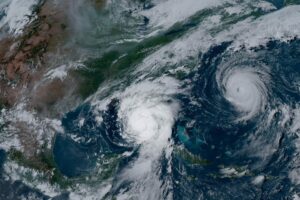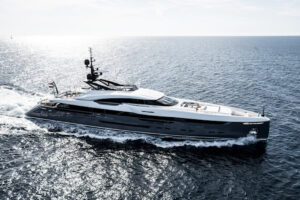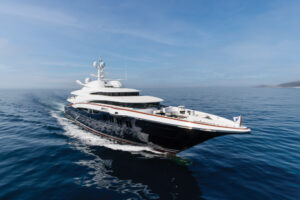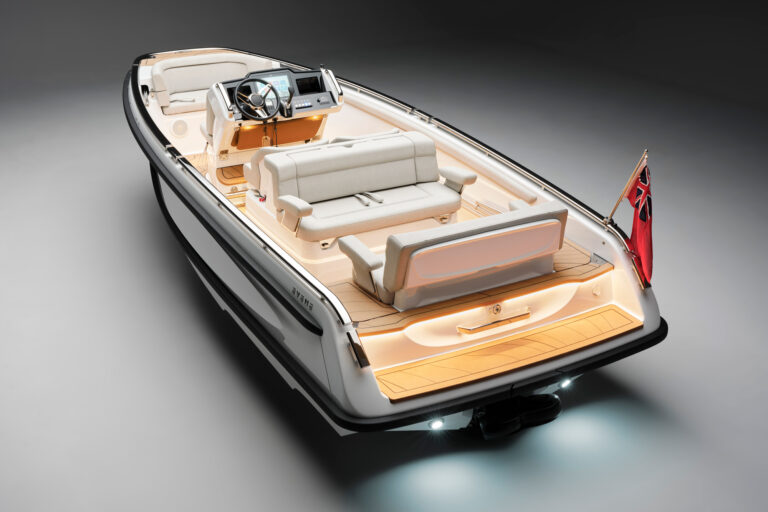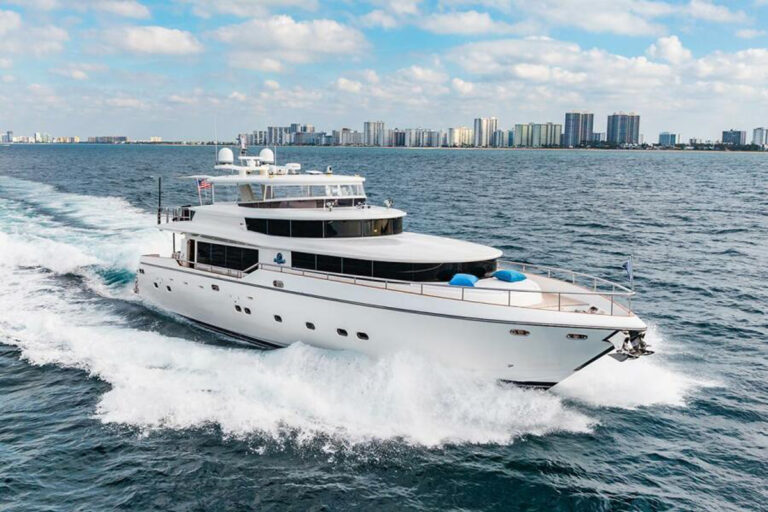Our five-man navigation aboard the newly purchased Eastbay 49 Hardtop Express became submarine-like in precision.
“The next mark will be a flashing red four-second.”
“How Far?”
“Two miles.”
“I have it on radar.”
“I see it about 11 o’clock.”
“Turn to 165.”
John Schanahan, owner of Oxford Yacht Agency in Oxford, Maryland, and I took turns on the chart calling marks. Buddy Puckhaber, a quintessential Southern gentleman, and his son George took turns watching the radar, looking ahead with the glasses and working the spotlight. We were at the wheel less than half the time, as first-time motoryacht owner Teddy Turner was reveling in his purchase.
That was fine with the rest of us. Driving a boat in the pitch-blackness at a good clip of speed should be a task reserved for the owner.
It wasn’t the first time I’d done “The Ditch,” as the ICW is often called. Like yachtsmen before and since, I’d slowly wound my way from Norfolk to Miami, motoring only in daylight. But Teddy had an agenda. We were to leave Maryland less than 40 hours before we were due in Charleston, South Carolina, for a Friday afternoon wedding party and to meet his wife and newborn son. The trip would be his first extended passage aboard the Eastbay, offering the rest of us an opportunity to watch an accomplished lifelong sailor embrace a motoryacht’s speed. He learned fast.
Of course, had we known about the quick purchase, quick sea trial and quick delivery of this boat, we would have found more than enough clues about how a boat ride would be in Teddy’s fast-moving world.
The Purchase
Buying a new boat often involves a search that drags out for months, even years. Boats are reviewed at boat shows. Brokers spend countless hours sending listing after listing.
Nobody clued Teddy in about this process. In the entrepreneurial form he honed in the fast-moving Internet world, he slashed the process down to a week. He logged onto the Web and typed in his search criteria: Down East style, speed and accommodations. Several possibilities popped up, including an Eastbay 49 Hardtop at the Oxford Yacht Agency. He reviewed the full listing and photos on Oxford’s Web site, liked what he saw and arranged a sea trial.
Several other prospective owners were not willing to move as fast. Most likely, neither were other dealers Teddy might have contacted. It was late February, one of the first winters in a long time when the Chesapeake Bay tributaries were frozen, a condition that would cause most dealers to send buyers a video and glossy brochure to hold them over until warmer spring weather.
“I asked (a local waterman) Wayne to meet me out there and break some ice ahead of the Eastbay with his workboat. We had a couple space heaters on board, but man, it was cold,” John said.
Teddy had only a narrow window between the time he arrived for the sea trial and the time he had to fly home. Ice or no ice, they were going for a ride. Although the water was calm, not allowing a true test, Teddy liked the boat. He headed back to the dock in Oxford, with Wayne and his makeshift icebreaker standing by at the river’s entrance, clearing a path.
“We dickered around on the price a little bit,” John said, “then agreed on a final number and did the deal.”
Turner owned the Eastbay 49 only seven days after seeing the listing on his computer screen.
The Departure
Forty-eight hours after John called, I was bound for the eastern shore of Maryland. The next morning, I found Teddy futzing on his new boat. C. Raymond Hunt and Associates designed her modified deep-V hull with 19 degrees of deadrise aft. She’s built on the heavy side, but she’ll cruise about 25 knots and hit a top speed of 30 with a pair of Caterpillar 660 hp 3196 TA diesels. John tweaked this 49 and upgraded the interior finish and appointments, including several items now standard on newer 49s. The 16-foot beam allows a fair amount of accommodations, including two staterooms, two heads and a full-size galley.
After tracking down John, Buddy and George, and grabbing a bag of sandwiches the deli left on the porch the night before, we were under way.
It was 10 a.m. Wednesday.
The Trip
Teddy’s first sea trial on the 49 was on a calm day, but our trip down the bay was during a ripper of a morning. Winds howled out of the northwest at 25 knots. Green water flew over the bow as we barreled along at 22 knots, forcing us to back off to about 19. The boat was solid. Her 45,000-pound mass shrugged off the chop.
Both Teddy and his friend George are accomplished sailors, and Buddy has put quite a few miles under the keel of a Kadey Krogen trawler at displacement speeds. Busting through waves and clicking miles off the log was new to them, and they soaked up every salt morsel with glee.
We flew through Hampton Roads and arrived at ICW mile marker zero at 5 p.m. As the sun set, reflecting off the black, glasslike swamp water, we negotiated the lock at Great Bridge at the mouth of the Albemarle-Chesapeake Canal. This is when most people stop, drop the hook and enjoy a nice meal, but normal cruising pleasantries were not part of our plans. We blazed down the narrow canal into the night’s darkness, cutting through the Great Dismal Swamp and keeping an eye on our radar to ensure we were in the middle of the slot.
The water was like molasses as we exited the canal and snaked our way down the North Landing River, smelling the aromas of land often less than a hundred yards away. We sped by in the dark at 20-plus knots.
Most folks idle their boats over for a stop at Coinjock Marina in North Carolina. We, too, could eat only so many day-old sandwiches with hard beige mayonnaise, but in true pit-stop fashion, we flew in and watched Teddy dock his Eastbay for one of the first times. We begged the waitress closing the place for last-minute service, and she showed true Southern hospitality in keeping us on schedule. Our total time at the dock was less than 45 minutes. We discussed staying at the marina for the night (it would have been fine with Buddy and me) but decided to knock off a couple more miles. We pulled away leaving other cruisers to wonder: Who the hell drives on the ICW at night? And who goes south in the spring?
Just after midnight, on Thursday morning, we dropped the hook in a cove on the east end of the Alligator-Pungo Canal. When we awoke later that morning, the wind remained strong as we continued our Low Country express. We settled on the reality that our entire trip would be spent inside because of the rough weather offshore.
Calling the bridge tender for the Onslow Beach Bridge at Camp Lejeune, we learned the bridge would not open because winds in excess of 35 knots had been clocked. We shook our heads, looked at the bridge and decided it would be a tight fit underneath. But with our schedule, it was worth a try.
We approached the structure slowly with a boathook on our bow marked at the boat’s highest point (the mast). We determined the mast had to come down. John and I stood atop the hardtop with 25- to 30-knot winds whipping by and watched my favorite faded hat get whisked into the distance as a swarm of helicopters buzzed close overhead from nearby Camp Lejeune. (Sure beats a day in the office.) Once the mast was down, we had a vertical clearance of about 13 feet, 6 inches-enough to get through after the half-hour delay.
At 5 p.m., we stopped for fuel in Wrightsville Beach, North Carolina. Servants of our schedule, we asked the dockmaster to top us off while we grabbed some chow at a Greek restaurant. We came back to find the fuel pump broken at the marina, so we headed across the channel to the next dock. So much for good planning. Our fuel consumption was about 25 gallons per hour, and we decided we could get close to Charleston with this refueling.
By nightfall, our tired, fuzzy minds strove to decipher a confusing confluence of channels, including Lockwood’s Folly and Shallotte. Buddy, dressed to the nines in his pajamas and ready for a decent night’s rest, suggested we stop. Having navigated these waters before, in daylight, he knew they were tricky. But like a bunch of punk kids ignoring our older, wiser father, we proceeded and made one of the oldest mistakes of the sea when navigating at night. We (read “I”) picked out a mark too far up the channel and cut past several others. “This doesn’t seem right,” is all Teddy had to say before we all realized the mistake. Sea grass and a beach several feet off our bow, illuminated by the spotlight, confirmed our realization.
It was time to sleep.
The Arrival
The next morning-less than 36 hours after we’d started our trip-my senses were acute, like those of anyone who has spent any amount of time within a fast-moving capsule. We rode from Wacca Wache Marina to a “diner” in a cab whose driver most likely escaped from a mental health facility. We arrived at the eatery, smack in the middle of the Bible Belt, and perused menus full of scepters as Christian radio bellowed from overhead speakers.
Not even a day removed, it was time to get back to sea.
During the home stretch, we formed our own predicted log race to the City Marina in Charleston. I took a glance at a few numbers, speed and charts and jotted my estimate down. Buddy, George and John put a little more effort into the process, but it was Teddy who studied and studied our course, time and averages, determining speed restrictions along the way. As we pulled into the City Marina and cut the engines, the owner’s estimate was closest, within minutes.
Pulling in, any hesitation Teddy had about docking his Eastbay was gone. This sailor-turned-powerboater pulled her in nimbly down a tight slot with larger vessels on both sides and parallel parked his new boat as if she were a VW Bug.
In just over 37 hours, we had traveled almost 600 miles along the ditch with no problems, no new-boat bugs.
George became so enamored with the trip, he went back home and bought a Hatteras 43 to live aboard. I found myself back on the waterway several weeks later moving at a more civilized pace, growing impatient and hoping maybe, just maybe, the captain would speed it up a bit.
Teddy had determined quickly that powerboating can be a lot of fun. He spent almost every spare moment on the boat this past summer, cruising from South Carolina to the Bahamas.
His newborn son, who was on board with him most of the time, is destined to have salt water screaming through his veins. Though maybe with a little more diesel in there than dear old dad.

